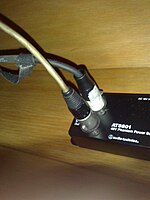Phantom power
In sound engineering, phantom power refers to a special type of remote power supply for signal sources that rely on a voltage supply. Usually these are condenser microphones and active DI boxes . The phantom power consists of a DC voltage that is transmitted via the microphone cable and offers greater reliability than batteries or rechargeable batteries in the device itself.
Structure and functionality
A phantom voltage of 48 V is common in professional audio technology, but there are also devices on the market with microphone inputs that only provide 24 V or 12 V. DIN 61938 (formerly DIN 45596) provides for voltages from 9 to 48 V. Most phantom powered microphones on the market can operate on voltages between 9 and 52 volts.
Phantom power depends on a symmetrical , shielded microphone connection with a continuous shield.
The positive pole of the supply voltage is applied in parallel to both signal wires, whereby a direct connection of the signal wires with one another must be prevented by a decoupling measure. The negative pole of the supply voltage is on the cable shield. Due to this special wiring, there is no voltage between the signal wires - and thus at the signal output of the signal source (hence the name "phantom"). The components that require power pick up the voltage between one of the two signal wires and the shield.
Possible interference voltages in the supply do not affect the signal due to the symmetrical cable routing ( common mode rejection ).
When connecting an unbalanced source to a phantom-fed input, the phantom power must either be switched off for this input or blocked with isolators.
Decoupling of the signal wires
In terms of circuitry, the phantom voltage can be fed into the signal wires via the center tap of an input transformer. In the case of transformerless inputs, the simpler method with two decoupling resistors is common, which prevent a short circuit of the signal wires, but also limit the maximum power that can be transmitted per wire. Depending on the voltage, the decoupling resistors are dimensioned as follows:
| tension | Resistance value | P max per wire |
|---|---|---|
| 48 V | 6.8 kΩ | 85 mW |
| 24 V | 1.2 kΩ | 120 mW |
| 12 V | 680 Ω | 53 mW |
The actual resistance value of the two decoupling resistors can deviate by up to 20% from the specified value. On the other hand, the equality of the two decoupling resistances of an input is very critical, the values of which may differ from one another by a maximum of 0.4%, as otherwise interference could occur.
Digital Phantom Power (DPP)
For digital microphones, the AES42 standard defines the so-called digital phantom power with 10 V at a maximum of 250 mA. Such microphones can be operated remotely by modulating the phantom voltage by ± 2 V.
Other audio engineering devices
Dynamic microphones
Dynamic microphones do not require phantom power, and on the other hand it does not damage the microphone (provided it is connected symmetrically). In practice it does not matter whether the phantom power is switched on or off. This distinguishes the phantom power supply from the nowadays only used in special cases according to DIN 45595, in which a direct voltage is applied parallel to the microphone capsule between the signal lines a and b , which would damage a dynamic microphone.
Ribbon microphones
Purely dynamic ribbon microphones with a transformer at the output do not require phantom power, but here, too, their special wiring prevents them from causing any damage - in contrast to the tone wire feed, which is short-circuited by the ribbon, which usually leads to the destruction of the ribbon. However, if active amplifier electronics are used instead of a transformer, they can use the phantom power supply for power supply.
Current ribbon microphones usually tolerate the application of phantom power.
DI boxes
Active DI boxes can usually also be operated using phantom power. In order to avoid that no signal is output at all when there is no power supply, some DI boxes have a bypass function, whereby the signal bypasses the electronics.
Optogate
Optogates also use the usual 48 V phantom power for power supply.
literature
- Hubert Henle: The recording studio manual. 5th edition, GC Carstensen Verlag, Munich, 2001, ISBN 3-910098-19-3
- R. Beckmann: Manual of PA technology, basic component practice. 2nd edition, Elektor-Verlag, Aachen, 1990, ISBN 3-921608-66-X
Web links
- Chapter 13 The 48V phantom power supply and its ghosts
- 48 VDC phantom power for condenser microphones


